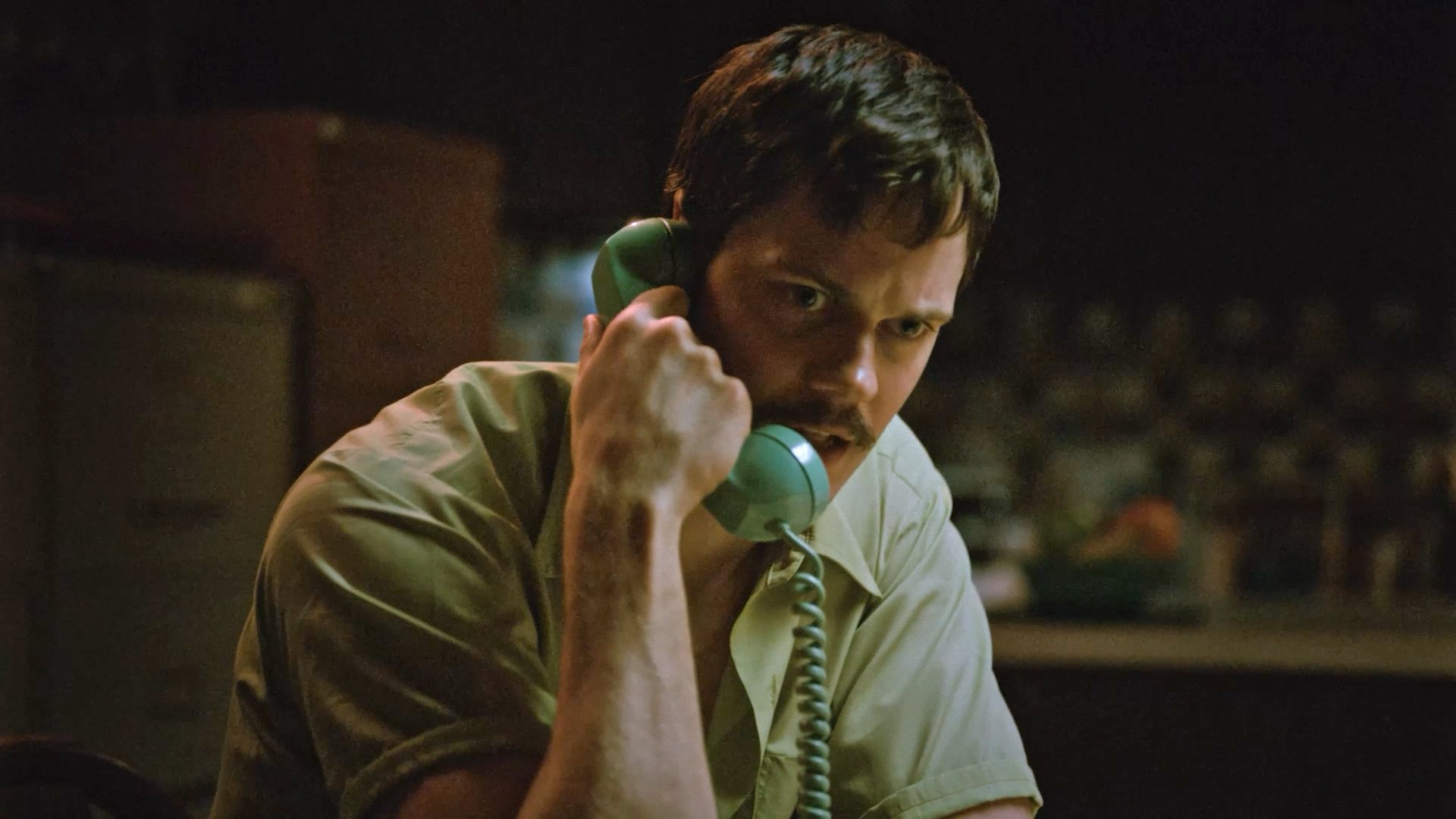AFF '25: Interview with Austin Kolodney on Dead Man’s Wire
This year’s Austin Film Festival witnessed a true full-circle moment for filmmaker Austin Kolodney. In 2022, he premiered his short film Two Chairs, Not One at AFF; in 2025, he came back to screen his feature debut Dead Man’s Wire, directed by Gus Van Sant, following its world premiere at the Venice International Film Festival.
Kolodney based Dead Man’s Wire on the true story of Tony Kiritsis, who kidnapped his mortgage broker in 1977 and held him hostage, wired to a shotgun, for three days. That 63-hour standoff becomes a taut crime thriller with an undercurrent of humor in Kolodney and Van Sant’s hands, with a cast including Bill Skarsgård, Colman Domingo, Myha’la and Al Pacino.
We sat down with Austin to talk about the movie’s dialogue on class rage, Bill Skarsgård fancams, and what it’s like having Gus Van Sant bring your words to life.
The following conversation has been edited for length and clarity.
What was the process of going from script to screen with this movie?
I started developing it in 2020 and started in earnest sending a draft out in 2021. Even in the early days I had in my mind the dream scenario of Gus Van Sant directing this. I tried to get it in his hands and didn't get it there on the first try. There were some ups and downs where it was almost going to get made, then it didn't, almost got made with another big, prolific filmmaker who I really admire, then it didn't work out there, and then ultimately, it did end up in Gus’s hands. Our producer, Cassian Elwes, put it in front of Gus and he read it, and the next day said, “I'm in. I'm available.”
It’s a dream come true. I was there on set, doing all the production revisions, and getting to watch and sponge up [Van Sant’s] directing style was really informative for me as a director. And that’s what I set out to do too—I was having trouble getting my first feature made as a director, so I wanted to write something that could be made in a more commercial, bigger way by a seasoned veteran like Gus, and be on set doing the production revisions, and just soak up their style and what works for them, what doesn't work for them, and learn from that. Just be a student of the game.
It’s been a dream to watch him work, and it's a surreal feeling to see your words now join the catalog of like Gus Van Sant’s filmography. He has such a wicked, sly sense of humor, but also knows how to tug at the heart strings and really make you feel for characters. And I just knew that he would be able to walk that tonal tightrope well and understand the themes that I was trying to put onto the page. And he elevated it and made it his own movie.
How did you stumble across Tony Kiritsis’ story, and what did your research look like as you began writing?
To be candid, the first time I heard about it was when Jamie Vernon, producer of the Joe Rogan Experience, mentioned it on a podcast. I went on YouTube to find more about it and found this five-minute clip that summates the events and shows Tony cracking these jokes, holding this press conference where you see him wiping away a tear and thanking everyone for coming out and supporting him, like he's accepting an Academy Award. I said out loud, this has to be a movie. So I started developing it as a film.
I was trying to get the web domain for TonyKiritsis.com and that led me to these filmmakers and historians, Alan Berry and Mark Enochs, who are these local Indianapolis guys who have done the most amount of research about this event. They have a documentary called Dead Man's Line, they have interviewed many cops and family members of Tony, they remember the event because they grew up in Indianapolis when they were kids, so they saw it happen live. And they were super generous about partnering with me and sharing their research—they had a 16 gigabyte folder with all these police reports and newspaper clippings and archival photos. So they gave me the foundation of lived-and-breathed research to use as a menu and pick from.
But in terms of my own takeaways, it was important for me to keep to the format and the structure of it being about the hostage event. I didn't want to make this movie that was a courtroom procedural, or a biopic where you're seeing Tony grow up. I wanted it to be this pressure cooker, boiler room, Dog Day Afternoon, Uncut Gems-style movie. So a lot of the movie is just in the room with Tony and Richard—and there were no cameras there for that at the time, so I put a lot of my own voice into those scenes between the two men.
I tried to do as much historical research as possible. Richard had written a book about this that I believe Daker had read, and I've listened to Richard on some podcasts talk about this event. There's many true crime podcasts. There’s a big smorgasbord of research. And having the historians, Alan and Mark, open their books gave me the confidence to tell the tale, but then also the confidence to veer from the nuts and bolts facts and figures, to sprinkle in my own voice, and sense of humor, and ideas for what makes for a good movie.
At the end of the film, there’s epilogue text sharing that the mortgage company Tony Kiritsis went up against eventually declared bankruptcy—everyone in my audience cheered for that. I’ve also seen comparisons between Tony and Luigi Mangione. I know you wrote this several years ago, but did you have a sense that this story of the wealthy versus the poor would resonate with audiences?
What drew me to the story is Tony's argument that the economic system of the time, and of our generation now, feels stacked against the common man. It feels like the idea of small business ownership or home ownership for many people in America who don't come from money is a distant dream, and that's a scary thing, and it's a frustrating thing. It's a movie about class and about rage, but then in writing, I was also finding empathy for Richard being in that situation where he, in the same way that Tony was, did not ask to be raised like this. Richard didn't ask to be raised or born into wealth any more than Tony did into poverty. It’s going to resonate because of the dialogue about class and wealth in America. That's what people were talking about in ‘77 and people are still talking about it now.
I wrote it in 2020 and then shortly before we started filming, the Luigi Mangione event happened, and it was jarring and it was fascinating to watch. You see this divisive event that has parallels [to the movie], although Tony’s case had a different outcome, but similar themes of inequality. It was interesting to see the real-time discourse about class and someone who is pushed over the limits into a place of violence because of a system that doesn't work.
You have a very stacked cast with big-name actors. What was it like seeing them bring your words to life?
It's a murderer's row. When you have an auteur like Gus, I describe it as he is the flame that the moths of talent attract to. So even though we didn't have all the money in the world, we were able to get Bill Skårsgard, Dacre Montgomery, Colman Domingo, Myha’la, Cary Elwes, John Robinson—who's worked with Gus before—Al Pacino, because it's Gus.
And I'd like to think that the characters on the page were fun to play. In particular, when I was writing the script, I knew that Tony was going to be such a juicy, fun role for any actor. Gus casting a younger version of both Tony and Richard was something that I didn't think to do, and it wasn't on the page, but when he did it, it opened us up to a new interpretation of events, and then also opened us up to have a movie that hits a different market. I see online all these Bill Skarsgard and Dacre Montgomery fan pages. These young fans of theirs are ravenous. It’s a two-hander, so there's a lot of intimate scenes and moments between these two guys, and I do envision these young Skarsgard girlies doing the fan edits of these guys, so that'll be fun.
It’s a cosmopolitan cast of all these different voices and prolific actors from these different types of shows and movies, but they all came together to work in one thing that is a Gus Van Sant movie. So it's unified with this one theme and this one style and voice. It’s gonna be fun to see people react to this.
What advice would you give to screenwriters who are where you were five years ago?
We’re here at the Austin Film Festival, and Rian Johnson is here, and he was one of the first people I got to talk to when I transferred to USC from community college. I got to see an early screening of Looper, and afterward he told me, “It’s an endurance game. I left USC in 1996 and Brick didn't come out til 2006, 10 years later.” I always say that there's a gap. A lot of people's Wikipedia pages are gonna have a gap. I left USC in 2015 and now this is 2025, but it wasn't like I was doing nothing and twiddling my thumbs. My advice to any screenwriter: go on set. Be a PA, go be a director's assistant. Go work any job that affords you the time to pay rent and keep the dream alive. I PA on stuff—my friends have other projects, and I'll help pack a cube truck and set up a lunch table. I've never stepped foot on set and not learned something, whether I'm there as the director, writer, art department, PA. I think it's always good to be on set and to keep soaking up the environment.
And get that spec written. Be prepared for when there is an opportunity to put a script in front of someone—no one wants to hear “I have an idea for a script,” they want to see it. If you're trying to break into screenwriting, it all starts on the page. There’s a quote that my mentor, John Watson, gave me: Scripts are the currency of our industry.
You should also be reading the screenplays that you admire, and you should be going to the movies—not just new releases, old ones too. There’s a lot of cool repertoire theater, revivalist cinema to check out. We have to feed the ecosystem that we claim we want to work in.
If you enjoyed this article, please consider becoming a patron of Hyperreal Film Journal for as low as $3 a month!



Alix is the editor-in-chief for Hyperreal Film Journal. You can find her on Letterboxd at @alixfth and on IG at @alixfm.